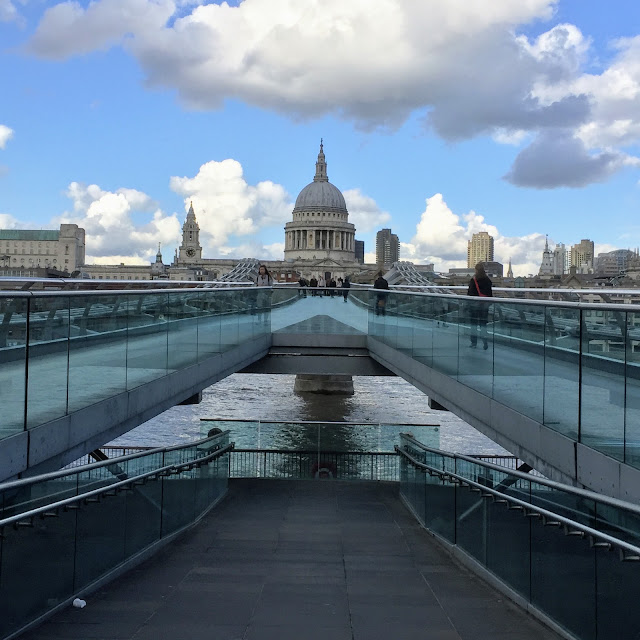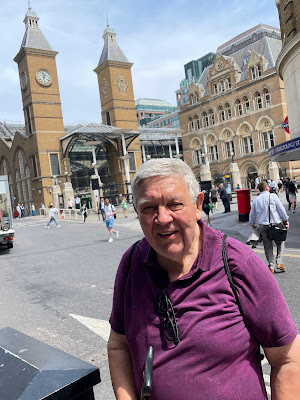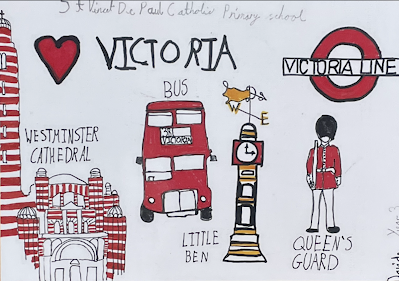Back to London
Having visited our grandchildren Tori and Robyn - what we most missed in London - it was time this week to take a day trip to catch sights in London not seen for six months. I sanitised the handles of a Santander bike and pedalled through Hyde Park where I noticed Rotten Row was being levelled. Did you know the ancient horse track formerly sloped across its width? Another change I noticed was the new patterned front Westminster residential and commercial centre towering across from the Abbey on Victoria Street. Joy to attend evensong there with a choir of seven and a congregation just three times that number.
Great to be back in London on a mid-September day trip from Haywards Heath made on quiet trains. I sanitised my Santander bike and headed for my online pre-booked visit to the National Gallery where I caught my first sight of Cezanne’s bathers for six months. I like the way the figures blend into their natural setting. My London experience was a more prosaic blending of mind and heart cycling through our great capital out of season people-wise. London Eye caught my eye cycling along the Embankment - what generous cycle provision there - 20 years on it seems as fitting as Boadicea opposite. More at http://freelondonfromvictoria.blogspot.com/
Back to London again on a quiet train to City Thameslink and a day criss crossing the Millennium Bridge between Tate Modern and St Paul’s. I remember its opening with the Bishops of London and Southwark in line to bless it, I think, and then there was a shaking set back! I enjoyed a morning in St Paul’s, where as priest I’m privileged with free entry, taking in more of the Cathedral. Down to St Stephen, Walbrook for lunch and their Choral Classics, back to St Paul’s to do the Crypt then across to Tate Modern for a totally different experience. Back across the bridge for Choral Evensong and a quiet train home.
The biggest of Cathedrals requires the biggest of incense burners. Unlike the swinging censer of Santiago de Compostela St Paul’s Cathedral, London’s thurible is large yet sedentary. Here it rests awaiting action off the sanctuary beside the memorial to St Paul’s great Dean, the poet John Donne. These sorts of thurible are coming into their own as priests currently celebrate the eucharist alone without servers due to necessary social distancing in the pandemic. At St Paul’s the Vergers get the charcoal going then clergy throw incense on the lighted coals in the thurible before the altar leading to a stream of incense smoke ascending the Dome. You can see in the picture how many self-lighting coals go into the censer, thirty compared to three used in the average thurible.
Stumbled across this memorial to T.E.Lawrence in the military section of the Crypt of St Paul’s Cathedral. I’d just read his ‘Revolt in the Desert’, an abridged version of ‘Seven Pillars of Wisdom’ and viewed a Channel 5 biography of Lawrence. I love his adventurous spirit and passion for justice which seemingly projected from an inner disquiet sourced in his upbringing. The Channel 5 programme brought out the paradox of Lawrence’s role in liberating Damascus from the Ottoman Turks in 1918 helping establish a provisional Arab government under King Faisal. When the world war ended Lawrence failed to convince the British government to support Arab independence and lived with ongoing sorrow at the betrayal of Arab interests in the lines drawn in the sand creating Syria which many now lament.
Walking from Victoria Station to the Tower of London beside the river I encountered this really long stretch of Albert Embankment devoted to the National Covid Memorial Wall created by bereaved families. ‘The hearts on this wall are in memory of our fellow citizens who have died since March 2020 with Covid-19 on their death certificates. Every heart represents a person who was loved’.
Enjoyed part of a day in London with one of my oldest friends, Nigel Brown who initiated me on the Elizabeth Line. We sped to its Abbey Wood terminus, explored the park, woods and Abbey ruins returning by rail to central London. More at https://freelondonfromvictoria.blogspot.com/
View from the train window. I’ve only recently discovered Cannon Street station adjacent to St Stephen, Walbrook where I’ve become devotee of their Thursday choral classics on occasional visits to London. Travelling from Haywards Heath via London Bridge it seems sensible to avoid steps down to the tube and make another short rail journey.
A newly accessible sight of London, made so through being eastern terminus of the Elizabeth Line, the scenic ruins of Lesnes Abbey founded by Richard de Luci in 1178 probably in penance for the murder of Thomas Becket, in which he was involved. Seeing buildings growing behind the decaying ruins in Lesnes Abbey Woods is a graphic reminder of what London is about. Canary Wharf is visible on the horizon.
Liverpool Street station was virtually unknown to me until my friend Nigel Brown suggested a rendezvous to explore the Elizabeth Line. Opened in 1874, now Britain’s third busiest station, it provides the starting point for journeys to Cambridgeshire, Essex, Greater London, Hertfordshire, Norfolk and Suffolk. The interior - resonant of some French stations I know - demonstrates modernisation which honours the best of its Victorian heritage.
THAMES WATERS
From Haywards Heath to Hampton Court
where train is exchanged for boat
carried on the Thames to Richmond.
The sun sparkles on waters
where regal swans glide
overseen by herons poised to fish.
‘Princess Freda’ scatters the geese
on her route downstream
plied day by day for a century.
King Henry’s Palace gives way
to wooded banks with weeping willows
past Teddington to Richmond.
Thames waters ply on incessantly
pushing their motor traffic
to London and the sea beyond.
John Twisleton 7 July 2022
River-tripping I caught extraordinary free access to the grounds of Hampton Court and, coincident with Wimbledon, its royal tennis court built around 1526 complete with players. ‘As a young man, Henry VIII was a keen and talented tennis player, who spent hours on court. His second wife Anne Boleyn was gambling on a game of tennis when she was arrested to be taken to the Tower of London. She even complained that she couldn't collect her winnings… One of the first English guides to tennis in 1553 claimed that this game has been created for a good purpose, namely, to keep our bodies healthy, to make our young men stronger and more robust, chasing idleness, virtue's mortal enemy. far from them and thus making them of a stronger and more excellent nature' (Hampton Court poster).
7 year old Davide’s view of my portal to London travelling from Haywards Heath. I love Victoria, use Little Ben as a place to meet up with friends and am a regular on the 38 bus. Good idea to display young people’s views of London as so much we miss in sight-seeing is readily captured by a child.

























Comments
Post a Comment